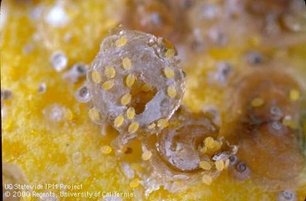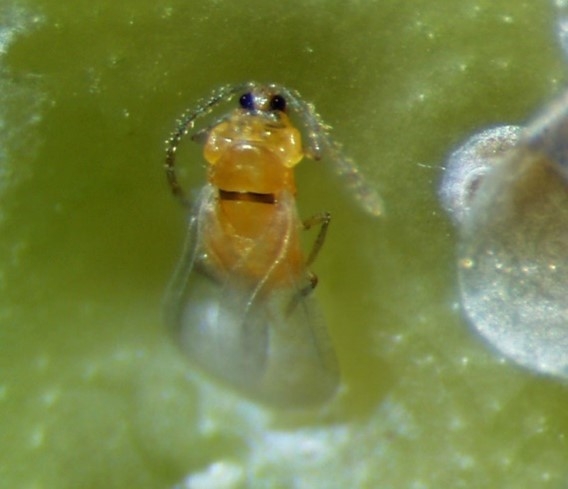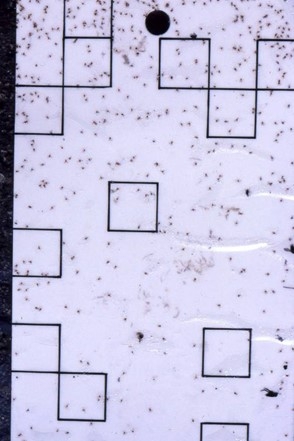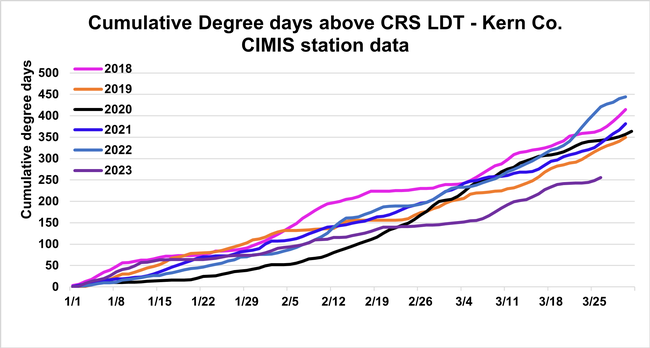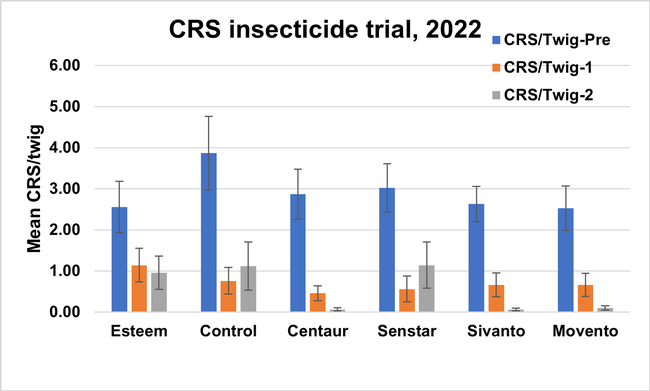Low average daily temperatures in 2023 is delaying California red scale season.
Sandipa Gautam
UCCE IPM Advisor
California red scale is a common pest of California citrus attacking leaves, twigs, fruit by sucking plant sap. If the scale numbers are high serious damage can occur to the trees and highly infested fruit may be downgraded in the packinghouse.
Biology and seasonal phenology of California red scale
California red scale has an interesting life cycle. CRS start out as mobile crawlers from overwintering females from a previous season (Figure 1), which only remain mobile until they find a suitable location to begin feeding. Once they start feeding, they do not move and go through development being attached to the feeding spot. Males are the only other moving stage (Figure 2). They go through active feeding stage (instars) and a dormant period (molting). Females molt twice and males molt four times and emerge as fliers. Males then find and mate with third instar female. Afterwards, gravid female starts producing crawlers, hence completing the life cycle. In the San Joaquin Valley, there are four complete generations of CRS. In years with warm winters/hot summers, fifth generation crawlers/immatures have been found.
Figure 1. CRS female (overturned) showing crawlers. Crawlers move around looking for feeding spot, settle and spend life on the same spot.
Figure 2. CRS male adult (top) and CRS males on trap card (bottom)
Monitoring male flights using Pheromone trap cards (Figure 2) and using degree days to predict the next life event - crawlers, male flight is a most used method for monitoring CRS seasonal activity in the San Joaquin valley. After every 550-degree day unit accumulation above the lower developmental threshold of CRS, 53°F, something important happens. My team at Lindcove Research and Extension Center has been monitoring degree days in Kern, Tulare, Fresno, and Madera counties. However, we have not had a biofix (first male flight) this year. Please visit https://lrec.ucanr.edu/Citrus_IPM/Degree_Days/ for degree day updates.
The average mean temperature in 2023 has been lower, what does this mean for CRS season?
Temperature data from CIMIS Station, Kern Co., shows that the cumulative heat units above the CRS lower developmental threshold trails lower than earlier years in 2023. To date, no male fliers have been caught in Kern Co. which is usually a week or more ahead of Fresno, Tulare, or Madera Counties. This indicates that CRS is developing, but at a slower rate than it had been in earlier years (Figure 3). Expect CRS male flights, crawler emergence to be 2-3 weeks late than normal years, at least for the first generation. If the summer temperature pattern stays similar to earlier years, we will have a delay in second and third generation too!
The effect of low temperature delaying the development, thereby affecting emergence and flights, will likely affect spray timing for CRS control in 2023 season.
Figure. 3. Cumulative degree days above the lower developmental threshold, 53°F, for CRS. Note, 2023 (green line) trails below other years.
California red scale trial- 2022
During 2022, our group studied the impact of multiple insecticide treatments on California red scale. The trials took place at the Lindcove Research and Extension Center. The trials were conducted as single tree applications and replicated 10 times. One application was made on July 28, following the crawler emergence. We rated the twigs on 23 September and twigs and fruit on 12 October for the presence of live California red scale. We also rated fruit for infestation by CRS, 0=no red scale, 1=1-10 scale, 2= >10 scales/fruit. The insecticides applied were Movento 10 fl. oz, Sivanto 14 oz, Centaur 46 oz, Senstar 20 oz, and Esteem 16 oz. All insecticides were applied with 1% Omni 6E 415 oil. Foliar applications of insecticides were made using a 100-gal high-pressure D30 diaphragm pump sprayer with mechanical agitation with a hand wand sprayer containing D6-nozzle at 250 psi. Treatments were applied in 750 gallons of water, except for Movento which was applied in 250 GPA, and Centaur which was applied at 1,000 GPA.
The insecticide that provided the best control in terms of reducing the percentage of fruit infested with >10 scales was Movento (Figure 4). Treatments, namely, Centaur, Senstar, Sivanto, and Movento significantly reduced the total CRS/fruit compared to control. In September, treatments did not significantly reduce CRS/twig compared to the control. In October, Centaur, Sivanto, and Movento, significantly reduced the mean number of mean live CRS on twigs (Figure 5). Treatments should be applied to provide thorough coverage according to the size of the trees, except for Movento which is recommended at 250 GPA at See the UCIPM guidelines for California red scale for more application details. 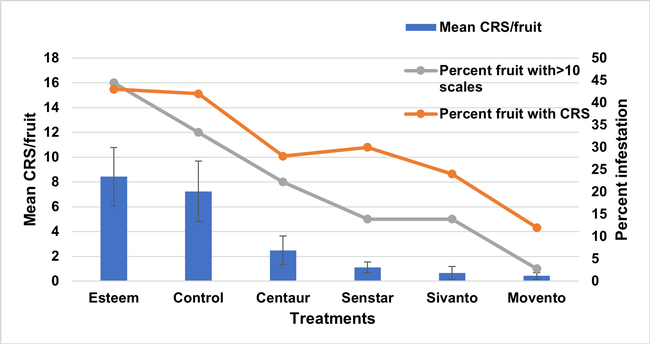
Figure 4. Mean live CRS per fruit on October 12 counts following insecticide treatment. All treatments were applied with 1% oil.
Figure 5. Mean live CRS/twig before and after treatments. Treatments were applied on July 28. Pretreatment count was done on July 25, and post-treatments counts were done on September 23, and October 12, respectively.
Attached Files:
